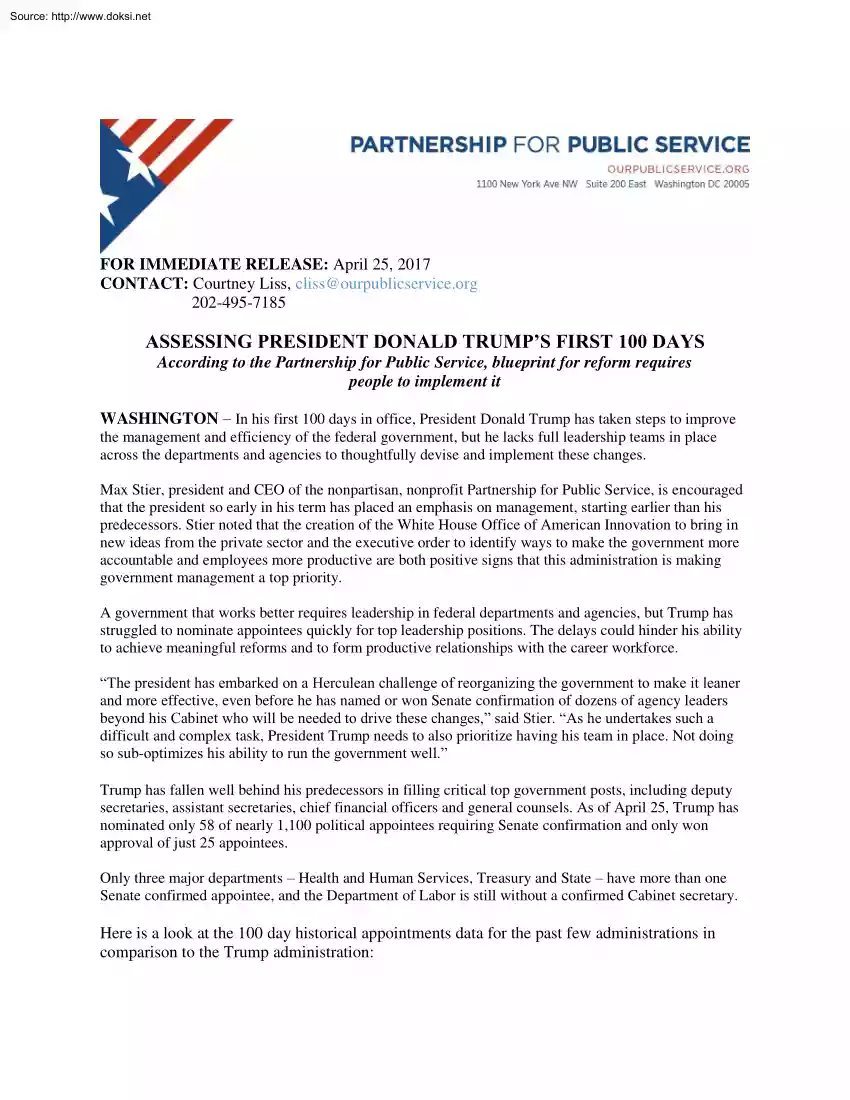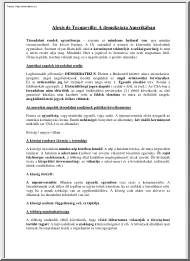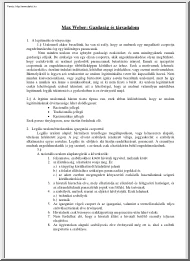Datasheet
Year, pagecount:2017, 2 page(s)
Language:English
Downloads:3
Uploaded:August 20, 2018
Size:819 KB
Institution:
-
Comments:
ourpublicservice.org
Attachment:-
Download in PDF:Please log in!
Comments
No comments yet. You can be the first!Most popular documents in this category
Content extract
Source: http://www.doksinet FOR IMMEDIATE RELEASE: April 25, 2017 CONTACT: Courtney Liss, cliss@ourpublicservice.org 202-495-7185 ASSESSING PRESIDENT DONALD TRUMP’S FIRST 100 DAYS According to the Partnership for Public Service, blueprint for reform requires people to implement it WASHINGTON – In his first 100 days in office, President Donald Trump has taken steps to improve the management and efficiency of the federal government, but he lacks full leadership teams in place across the departments and agencies to thoughtfully devise and implement these changes. Max Stier, president and CEO of the nonpartisan, nonprofit Partnership for Public Service, is encouraged that the president so early in his term has placed an emphasis on management, starting earlier than his predecessors. Stier noted that the creation of the White House Office of American Innovation to bring in new ideas from the private sector and the executive order to identify ways to make the government more
accountable and employees more productive are both positive signs that this administration is making government management a top priority. A government that works better requires leadership in federal departments and agencies, but Trump has struggled to nominate appointees quickly for top leadership positions. The delays could hinder his ability to achieve meaningful reforms and to form productive relationships with the career workforce. “The president has embarked on a Herculean challenge of reorganizing the government to make it leaner and more effective, even before he has named or won Senate confirmation of dozens of agency leaders beyond his Cabinet who will be needed to drive these changes,” said Stier. “As he undertakes such a difficult and complex task, President Trump needs to also prioritize having his team in place. Not doing so sub-optimizes his ability to run the government well.” Trump has fallen well behind his predecessors in filling critical top government
posts, including deputy secretaries, assistant secretaries, chief financial officers and general counsels. As of April 25, Trump has nominated only 58 of nearly 1,100 political appointees requiring Senate confirmation and only won approval of just 25 appointees. Only three major departments – Health and Human Services, Treasury and State – have more than one Senate confirmed appointee, and the Department of Labor is still without a confirmed Cabinet secretary. Here is a look at the 100 day historical appointments data for the past few administrations in comparison to the Trump administration: Source: http://www.doksinet Trump (as of April 25) Obama W. Bush Clinton H.W Bush Nominated 58 190 85 176 95 Confirmed 25 69 35 49 50 "Failed" 2 3 0 2 1 Average Days to Confirm 27 24 8 13 21 Additionally, the pending number of appointees to clear federal ethics requirements is striking compared to that of the Obama administration. As of April 17, Trump had only submitted 41
percent of the nominee reports that his predecessor submitted in 2009, according to Office of Government Ethics data. However, it is a positive development that the president in his first 100 days has encouraged agencies to collaborate in the delivery of important services and programs to the public, called for streamlining mission-support functions like IT, acquisition and financial management and wants to reduce overlapping programs to save taxpayer money and increase effectiveness. Stier cautioned that Trump’s emphasis on dramatically reducing the size of the workforce could be counterproductive and needs to be carried out strategically to avoid losing essential talent and diminishing the quality of services delivered to the public. He noted that workforce reductions in past administrations have led to unintended consequences. “Previous government-wide workforce reductions hampered, not helped, government effectiveness,” said Stier. “The loss of front-line employees led to
backlogs in services at customer-focused agencies such as the IRS, Social Security Administration and at veterans’ hospitals. Some of these cutbacks also ended up costing the government money in the long run.” “The goal of a workforce realignment should be to produce better service for the public,” added Stier. “This means setting goals, deploying people and resources accordingly, monitoring progress and ensuring accountability for results.” Stier urged Trump to work closely with Congress and to get input from career executives who understand the workings of their agencies, stating that the real test for this administration will be in the details of these various initiatives, how they will be carried out and the impact they have on the effective operation of the government. For 15 years, the nonpartisan, nonprofit Partnership for Public Service has been dedicated to making the federal government more effective for the American people. We work across administrations to help
transform the way government operates by increasing collaboration, accountability, efficiency and innovation. Visit ourpublicserviceorg to learn more ###
accountable and employees more productive are both positive signs that this administration is making government management a top priority. A government that works better requires leadership in federal departments and agencies, but Trump has struggled to nominate appointees quickly for top leadership positions. The delays could hinder his ability to achieve meaningful reforms and to form productive relationships with the career workforce. “The president has embarked on a Herculean challenge of reorganizing the government to make it leaner and more effective, even before he has named or won Senate confirmation of dozens of agency leaders beyond his Cabinet who will be needed to drive these changes,” said Stier. “As he undertakes such a difficult and complex task, President Trump needs to also prioritize having his team in place. Not doing so sub-optimizes his ability to run the government well.” Trump has fallen well behind his predecessors in filling critical top government
posts, including deputy secretaries, assistant secretaries, chief financial officers and general counsels. As of April 25, Trump has nominated only 58 of nearly 1,100 political appointees requiring Senate confirmation and only won approval of just 25 appointees. Only three major departments – Health and Human Services, Treasury and State – have more than one Senate confirmed appointee, and the Department of Labor is still without a confirmed Cabinet secretary. Here is a look at the 100 day historical appointments data for the past few administrations in comparison to the Trump administration: Source: http://www.doksinet Trump (as of April 25) Obama W. Bush Clinton H.W Bush Nominated 58 190 85 176 95 Confirmed 25 69 35 49 50 "Failed" 2 3 0 2 1 Average Days to Confirm 27 24 8 13 21 Additionally, the pending number of appointees to clear federal ethics requirements is striking compared to that of the Obama administration. As of April 17, Trump had only submitted 41
percent of the nominee reports that his predecessor submitted in 2009, according to Office of Government Ethics data. However, it is a positive development that the president in his first 100 days has encouraged agencies to collaborate in the delivery of important services and programs to the public, called for streamlining mission-support functions like IT, acquisition and financial management and wants to reduce overlapping programs to save taxpayer money and increase effectiveness. Stier cautioned that Trump’s emphasis on dramatically reducing the size of the workforce could be counterproductive and needs to be carried out strategically to avoid losing essential talent and diminishing the quality of services delivered to the public. He noted that workforce reductions in past administrations have led to unintended consequences. “Previous government-wide workforce reductions hampered, not helped, government effectiveness,” said Stier. “The loss of front-line employees led to
backlogs in services at customer-focused agencies such as the IRS, Social Security Administration and at veterans’ hospitals. Some of these cutbacks also ended up costing the government money in the long run.” “The goal of a workforce realignment should be to produce better service for the public,” added Stier. “This means setting goals, deploying people and resources accordingly, monitoring progress and ensuring accountability for results.” Stier urged Trump to work closely with Congress and to get input from career executives who understand the workings of their agencies, stating that the real test for this administration will be in the details of these various initiatives, how they will be carried out and the impact they have on the effective operation of the government. For 15 years, the nonpartisan, nonprofit Partnership for Public Service has been dedicated to making the federal government more effective for the American people. We work across administrations to help
transform the way government operates by increasing collaboration, accountability, efficiency and innovation. Visit ourpublicserviceorg to learn more ###





 When reading, most of us just let a story wash over us, getting lost in the world of the book rather than paying attention to the individual elements of the plot or writing. However, in English class, our teachers ask us to look at the mechanics of the writing.
When reading, most of us just let a story wash over us, getting lost in the world of the book rather than paying attention to the individual elements of the plot or writing. However, in English class, our teachers ask us to look at the mechanics of the writing.